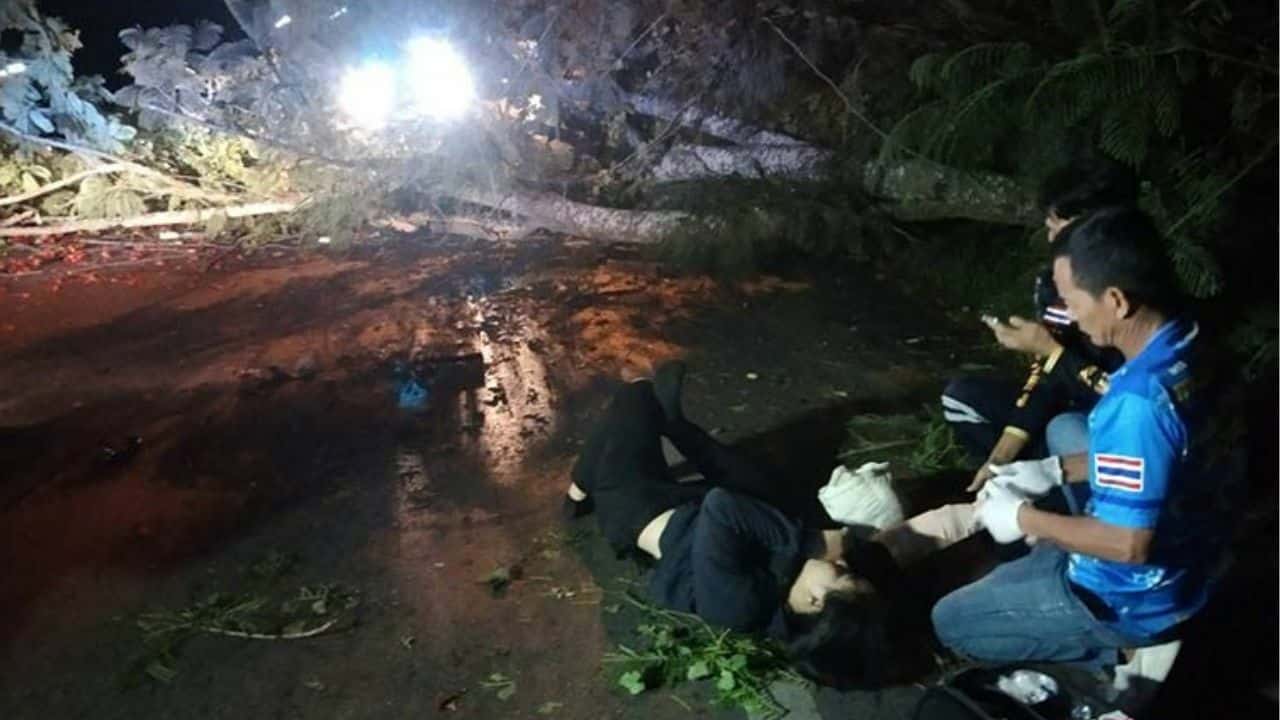Sometimes, nature shows us how powerful it really is—turning a normal day into a tragic one in the blink of an eye. A heartbreaking incident in Chon Buri, Thailand, recently reminded everyone of just that. A sudden gust of strong wind caused a large tree to fall, tragically landing on a motorcyclist and ending his life on the spot. This unfortunate event not only shook the local community but also raised serious questions about safety, weather preparedness, and the unpredictability of natural forces.
Let’s take a closer look at what happened, why it matters, and how we can all learn from this sorrowful story.
What Happened in Chon Buri?
A Routine Ride Turned Fatal
It was an ordinary day in Chon Buri province. People were going about their lives, including a 54-year-old man riding his motorcycle along a regular road. Nothing seemed out of the ordinary—until strong winds suddenly swept through the area.
In mere moments, a massive roadside tree, unable to withstand the pressure of the wind, cracked and came crashing down. Tragically, the tree fell directly onto the passing motorcyclist. Despite immediate help and calls for emergency services, the man was pronounced dead at the scene. His body was discovered pinned beneath the fallen trunk, his white Honda motorbike crushed beyond repair.
This tragic moment, as fast as a snap of your fingers, turned a peaceful ride into a life-ending disaster.
The Impact of Natural Forces on Daily Life
Why Wind Can Be More Dangerous Than It Looks
When we think about dangerous weather, we usually imagine storms, floods, or maybe even heatwaves. But wind? It often feels harmless—just a gentle breeze or, at most, a strong gust pushing against our umbrellas.
However, as this incident painfully shows, wind can be deadly. Strong winds are capable of snapping branches, knocking down trees, and even toppling power lines. And when these forces act in public areas—on streets, near homes, or beside highways—the danger skyrockets.
Think of wind like an invisible heavyweight boxer. You don’t see it coming, but when it hits, it hits hard.
Infrastructure vs. Nature: A Constant Battle
Trees offer beauty, shade, and environmental benefits. But when they’re old, diseased, or not maintained properly, they can become ticking time bombs. This is especially true during extreme weather.
In the Chon Buri case, it’s still unclear whether the tree was already weakened or simply fell due to the sheer force of the wind. Either way, it highlights a critical point: urban planning and maintenance must keep up with changing weather patterns.
What Can Be Done to Prevent Such Accidents?
A Wake-Up Call for Local Authorities
This tragic incident should serve as a wake-up call—not just for Chon Buri, but for cities and towns across Thailand. Local governments need to take proactive steps in assessing the risks posed by trees and other infrastructure during windy seasons.
Here are some simple, yet effective measures that can help:
-
Regular Tree Inspections: Identify weakened or overgrown trees, especially those near roads or public areas.
-
Strategic Pruning: Trim branches that could pose risks if blown by wind.
-
Community Reporting Systems: Allow residents to report potentially dangerous trees.
-
Weather Alerts: Implement real-time alerts for strong winds and other sudden weather changes.
-
Training for Emergency Response Teams: Equip first responders with tools to handle weather-related incidents quickly and efficiently.
Personal Safety Tips for Commuters
We can’t control the weather, but we can control how we respond to it. If you’re a motorcyclist or pedestrian, consider these precautions:
-
Avoid riding during storm warnings or periods of strong winds.
-
Stay alert to your surroundings—look for swaying trees or falling branches.
-
If you see an unstable tree, report it to local authorities.
-
Park vehicles away from large trees during wind forecasts.
Being cautious for just a few extra minutes might save your life.
Table: Comparing Risks from Various Weather Events
| Weather Event | Primary Danger | Preventive Measures |
|---|---|---|
| Heavy Rain | Flooding, slippery roads | Avoid low areas, drive cautiously |
| Strong Wind | Falling trees, flying debris | Stay indoors, report unstable trees |
| Thunderstorms | Lightning strikes, power outages | Unplug devices, avoid open fields |
| Heatwaves | Dehydration, heatstroke | Stay hydrated, avoid midday exposure |
| Fog | Low visibility | Use headlights, reduce speed |
Conclusion
Life can be unpredictable, and nature doesn’t always give warnings. The tragic accident in Chon Buri is a somber reminder of the unseen dangers we face every day—especially from forces like wind that we often underestimate. While nothing can undo the pain caused by this loss, it does offer us a chance to reflect, take action, and build safer environments for ourselves and future generations.
Let this not just be another sad headline, but a turning point where awareness leads to prevention.
